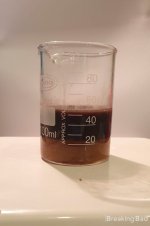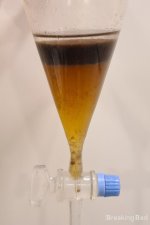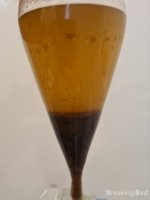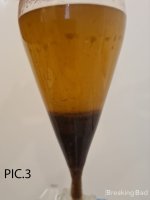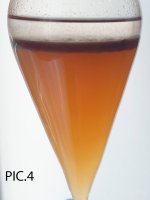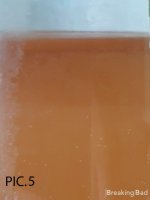- Language
- 🇺🇸
- Joined
- Mar 27, 2022
- Messages
- 288
- Reaction score
- 170
- Points
- 43
The following observation, which synthesis route to amphetamine does not matter.
After the A-freebase is released with the addition of NaOH and collects oilily on the surface, I perform an extraction with petroleum ether.
First I transfer the solution to a cylinder and wait for the layers to form. With a syringe I collect the upper layer in an Erlenmeyer flask. Then the solution comes into the separating funnel and is shaken with 10% of the volume of the solution 3 times with petrol ether and also collected in the Erlenmeyer.
Here it is noticed that the amphetamine base does not mix completely with the petroleum ether and two layers are formed here as well.
The Erlenmeyer is dried with 1-2 teaspoons of MgSO₄ and now something strange happens.
The solution becomes thicker and thicker even shaking does not help, it becomes a mush. Two hours in the freezer and then vacuum filtered and I now have much more salt than I added.
What happens here?
Does the A-freebase react with the SO₄ from the MgSO₄ and form amphetamine sulfate?
When I partially dissolve the salt in a beaker with water, an oily layer forms again. After adding NaOH, the upper layer can be extracted and placed together with the petroleum ether on a dish to evaporate the ether.
Who can tell me what happens there with the MgSO₄ during drying, is another desiccant to choose?
Use something else like petroleum ether?
Am grateful for any help. thanks
After the A-freebase is released with the addition of NaOH and collects oilily on the surface, I perform an extraction with petroleum ether.
First I transfer the solution to a cylinder and wait for the layers to form. With a syringe I collect the upper layer in an Erlenmeyer flask. Then the solution comes into the separating funnel and is shaken with 10% of the volume of the solution 3 times with petrol ether and also collected in the Erlenmeyer.
Here it is noticed that the amphetamine base does not mix completely with the petroleum ether and two layers are formed here as well.
The Erlenmeyer is dried with 1-2 teaspoons of MgSO₄ and now something strange happens.
The solution becomes thicker and thicker even shaking does not help, it becomes a mush. Two hours in the freezer and then vacuum filtered and I now have much more salt than I added.
What happens here?
Does the A-freebase react with the SO₄ from the MgSO₄ and form amphetamine sulfate?
When I partially dissolve the salt in a beaker with water, an oily layer forms again. After adding NaOH, the upper layer can be extracted and placed together with the petroleum ether on a dish to evaporate the ether.
Who can tell me what happens there with the MgSO₄ during drying, is another desiccant to choose?
Use something else like petroleum ether?
Am grateful for any help. thanks
↑View previous replies…
- Language
- 🇬🇧
- Joined
- Dec 27, 2021
- Messages
- 183
- Reaction score
- 110
- Points
- 28
ACAB, I have re-read your post and I think the key to the problem is in this sentence:
`Here it is noticed that the amphetamine base does not mix completely with the petroleum ether and two layers are formed here as well.` This means that the layer what you extract as `oily base` is not pure oily base. Why don`t you use some petroleum ether (or other non-polar solvent) here too? I mean from the point your solutions reaches pH12 and a layer forms, it is ok, to separate the oily layer, but put this in the separating funnel and add equal amount of petroleum ether, then save the petroleum ether layer in the Ehrlenmeyer if two layers are formed. The not petroleum ether layer (if it forms) you can add to the original water and then extract with the rest of the water. Using only 10% of the water volume 3 times is probably too little, use 30% then 20% then 20%.
I know it is quite a lot of ether, you can use the water as indicator: the water becomes almost clear when most of the oil has been extracted.
Combine the petrol ether fractions add them to the separating funnel and wash at least 2-3X with distilled water, then 1X with brine (saturated NaCl solution). Then start drying it, but only add `enough` MgSO4, not `more is better`. When the MgSO4 is showing snowball effect after 15-20 minutes, then you are good. If you have mol sieve then you can use that too instead of MgSO4/Na2SO4. GRAVITY filter the MgSO4. I don`t really like it as it has quite small molecular size and might come through some filters and need filtering more than one time.
When you have your clear and dry petrol ether then distill it, so that using more before won`t matter, you get it back. You should do this anyway with most of your solvents.
Also, as a general rule, when cooling or just leaving outside any dry solutions, never forget to cover it with kitchen kling film and a rubber band so that it is airtight.
Let us know if the problem still persists if you follow this way.
`Here it is noticed that the amphetamine base does not mix completely with the petroleum ether and two layers are formed here as well.` This means that the layer what you extract as `oily base` is not pure oily base. Why don`t you use some petroleum ether (or other non-polar solvent) here too? I mean from the point your solutions reaches pH12 and a layer forms, it is ok, to separate the oily layer, but put this in the separating funnel and add equal amount of petroleum ether, then save the petroleum ether layer in the Ehrlenmeyer if two layers are formed. The not petroleum ether layer (if it forms) you can add to the original water and then extract with the rest of the water. Using only 10% of the water volume 3 times is probably too little, use 30% then 20% then 20%.
I know it is quite a lot of ether, you can use the water as indicator: the water becomes almost clear when most of the oil has been extracted.
Combine the petrol ether fractions add them to the separating funnel and wash at least 2-3X with distilled water, then 1X with brine (saturated NaCl solution). Then start drying it, but only add `enough` MgSO4, not `more is better`. When the MgSO4 is showing snowball effect after 15-20 minutes, then you are good. If you have mol sieve then you can use that too instead of MgSO4/Na2SO4. GRAVITY filter the MgSO4. I don`t really like it as it has quite small molecular size and might come through some filters and need filtering more than one time.
When you have your clear and dry petrol ether then distill it, so that using more before won`t matter, you get it back. You should do this anyway with most of your solvents.
Also, as a general rule, when cooling or just leaving outside any dry solutions, never forget to cover it with kitchen kling film and a rubber band so that it is airtight.
Let us know if the problem still persists if you follow this way.
- Language
- 🇺🇸
- Joined
- Mar 27, 2022
- Messages
- 288
- Reaction score
- 170
- Points
- 43
I assume that the formed layer can be separated (for me this is A-oil, because something else cannot be in there, except impurities, after I have released the freebase) and I only have to extract the rest of the solution with petroleum ether. Is this assumption not correct?
Because if I try to extract the two layers with petroleum ether, I always have 3 layers and I do not get everything extracted, or I would have to make many extractions until the middle layer is completely dissolved. If that is possible at all.
Because if I try to extract the two layers with petroleum ether, I always have 3 layers and I do not get everything extracted, or I would have to make many extractions until the middle layer is completely dissolved. If that is possible at all.
G.Patton
Expert
- Joined
- Jul 5, 2021
- Messages
- 3,032
- Solutions
- 3
- Reaction score
- 3,438
- Points
- 113
- Deals
- 1
Hi, amph base reacts with Mg2+ ions after a long exposition. I think it is a reason of your mash formation. It isn't best desiccant for amines. Na2SO4 is better for this procedure.
↑View previous replies…
- Language
- 🇺🇸
- Joined
- Mar 27, 2022
- Messages
- 288
- Reaction score
- 170
- Points
- 43
- By ACAB
Ok, but what you mean with long exposition? The reaction starts immediately after putting the salt into the solution.
And MgSO4 is also recommended here in the article as a desiccant, I was not familiar with anything else before, but what else do we extract other than amines?
I will try that first, because that also matches with my observation that A-freebase must have reacted with the salt, because the filtered salt released the base again after dissolving in water.
And MgSO4 is also recommended here in the article as a desiccant, I was not familiar with anything else before, but what else do we extract other than amines?
I will try that first, because that also matches with my observation that A-freebase must have reacted with the salt, because the filtered salt released the base again after dissolving in water.

